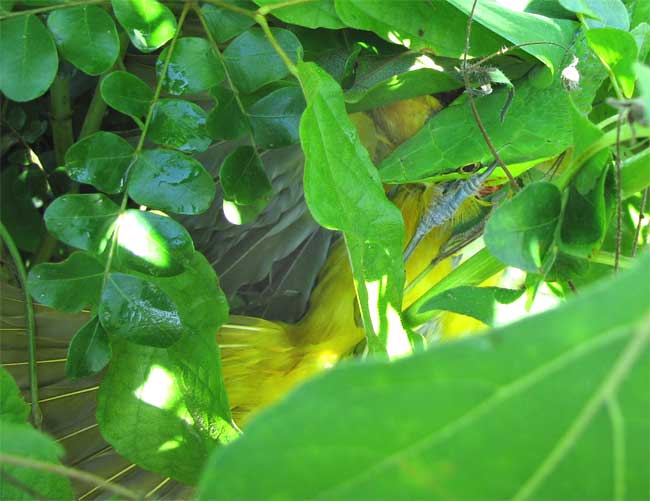Excerpts from Jim Conrad's
Naturalist Newsletter
from the November 17, 2008 Newsletter written in Yokdzonot about half an hour by bus west of Pisté, Yucatán, México
elevation ~25m (~82 ft), N20.707°, W88.731°
GREEN VINE SNAKE DOWN IN THE WEEDS

Tuesday morning a couple of hours after sunrise I was winding my way through a 20-acre patch of weeds surrounded by forest, maybe an abandoned cornfield or the remains of an area scalped for charcoal making. It was a waist-high, emerald-green sea of dew-wet morning-glory vines sprawling over annual herbs and grasses. I was approaching a flock of about a dozen tightly clustered, black Melodious Blackbirds perched atop weeds making curious, sharp piik! piik! piik! calls.
Something was going on there upsetting the blackbirds and I had an idea it might be a snake. As I approached the complaining birds they flew away, and then I could hear another bird desperately issuing its distress call. "Snake has a bird," I thought.
The weeds were so thick that I couldn't see a thing unusual from four feet away. A bit closer something yellow down in the weeds' shadows showed up; I watched as the yellowness rose higher inside the weeds, but, suggestively, not under its own power. It was being pulled upward by something. Now I could see that it was clearly a levitating bird, one belly-up, probably an immature or female Hooded Oriole, but where was that snake?
Less than three feet away finally I saw what is shown in the at-first-maybe-hard-to-interpret photo at the top of the page.
Can you see the actors in this drama? Several people here looked at the photo for over a minute before they discovered the bird. Even with my face just inches from the real thing it took awhile before I realized that the green form at the picture's top right wasn't a leaf but rather the beady-eyed head of OXYBELIS FULGIDUS, the Green Vine Snake. Can you see the bird's toenail almost sticking the snake in the eye? It looks like the oriole's beak and forehead are caught in the snake's mouth.
In the photo you can barely make out how the snake's body narrows drastically behind the head. It's remarkable that such a large bird can be ingested into such a slender body. Several times I've seen Green Vine Snakes dangling vinelike in trees and their bodies always strike me as so absurdly slim that it's hard to imagine their meager musculature enabling them to climb trees, much less subdue prey much larger than themselves.
Jonathan Campbell in Amphibians and Reptiles of Northern Guatemala, the Yucatán, and Belize writes that Green Vine Snakes feed heavily on birds, but also rodents, anoles and other lizards. The snake tends to wait for prey to come within reach instead of foraging actively. I was surprised to find it in the center of a large, weedy field because it's considered an arboreal species.
Green Vine Snakes, which reach at least 6.5 feet long (2 m) are distributed from Mexico's Isthmus of Tehuantepec southward to Argentina. Because of this large distribution, its relative commonness and striking appearance it's among the American Tropic's most representative reptilian species.